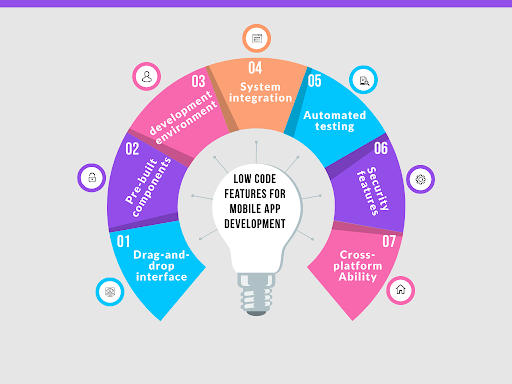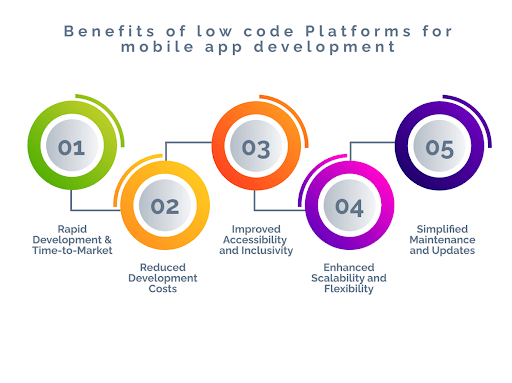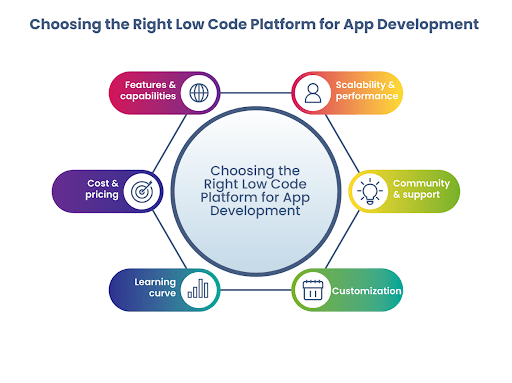Introduction
On the back of low code platforms for app development, in 2023, mobile applications and their downloads reached the predicted $255 billion, which is 80% more than the levels identified in 2018. However, such approaches fail to meet the growing demand since they cause project delays and increase costs.
Low code mobile app development has immense advantages for building mobile applications. It accelerates app creation and helps businesses build strong, highly technological, and scalable applications at a relatively low price, opening a new paradigm in mobile application development.
Low code application development employs graphical user interfaces and application blocks with little hand-coding. These low code platforms for app development facilitate the conception, testing, and deployment of apps in various industries of app development services.
Understanding Low Code Platforms for Mobile App Development
Definition
Low code platforms for app development are an approach that involves quick application development and deployment while minimizing the use of hand-code programming; instead, it incorporates the use of graphical user interfaces, model-driven elements, and drag-and-drop elements to design functions, user interfaces, and the integration of multiple components.
Low Code Features for Mobile App Development
Drag-and-drop interface: It helps developers to easily design and lay out the UI of the application as a true representation of the final product through the actual use of GUI by just dragging the already existing shapes, thus making app creation in low code application development is a less time-consuming process.
Pre-built components: They provide a collection of reusable UI components, functions, and modules for the app with the aim of shortening the time taken to develop on the low code app development platforms.
Visual development environment: A tool for the design of app logic, workflows, and data models that avoid scripting and help both developers and non-developers to participate in cross-platform app development.
Integration with existing systems: They enable the connection with different databases, APIs, or other third-party service providers or frameworks for building integrated and complex applications in the low code application development environment.
Cross-platform compatibility: It enables developers to design and develop applications that can be deployed into different systems, mainly the iOS, Android, and Web systems, from a single code base, thus enabling cross-platform mobile application development.
Built-in security features: They include security standards and all regulations to address the issue of shielding the apps developed under low code application development tools from daily threats and risks.
Automated testing and deployment: It consists of features like auto testing and one-click deployment so that there are fewer chances of error and to speed up the process of releasing in low code platforms for app development.
Collaborative features: They help to make work on documents more effective and organized, especially during teamwork on applications built in different platforms and languages.
Benefits of Low Code Platforms for Mobile App Development
Rapid Development and Time-to-Market
Faster development: Low code platforms reduce by as much as 90% the amount of time taken to develop an app, given that there are visual tools and pre-built elements available.
Accelerated time-to-market: Faster development means that businesses can get to market, exploit opportunities, and gain competitive advantage much quicker.
Case study: Schneider Electric implemented a customer portal within 8 weeks using the low code platform for mobile app development and cut down the time to market by 75% within the time taken by the traditional method.
These benefits of low code mobile app development are valuable for companies that are collaborating with a mobile app development company in Delhi for faster cross-platform mobile application development.
Reduced Development Costs
Lower labor costs: With low code platforms, there is likely to be less demand for mammoth specialized development teams; thus, there is a possibility of inventorying the labor costs of such a development team by up to a measure of 70%.
Cost-effective development: People can attain more with fewer people because low code app development platforms allow organizations to quickly build and test prototypes.
Cost-Saving Strategies Using Low Code Platforms:
Leverage citizen developers: Teach non-IT workers to create simple applications, lowering the need for costly development tools and encouraging creativity among employees in multiple departments for low code mobile application development.
Prioritize reusability: Design and develop a library of components and templates to reuse, which will save a considerable amount of time and money that might be used in future projects on your contextually interactive application development environment.
Implement agile methodologies: Rapid prototyping and iterative development through low code platforms can be used to efficiently build prototypes and have continuous feedback for app development services without compromising the quality.
Optimize cloud resources: Minimize the infrastructure costs by implementing low code platforms in the cloud and scaling resources proportionately for optimal low code mobile application development.
Automate testing and deployment: Look for in-built testing and deployment tools to avoid the need for a lot of manual work or costs in the application development platform.
Focus on cross-platform development: Leverage low code solutions and build apps hosting on multiple platforms with single code, making app development services inexpensive in terms of development and maintenance.
Improved Accessibility and Inclusivity
Accessibility features: Many low code platforms are equipped with pre-designed accessibility tools to ensure that applications are designed for users of all different abilities.
Inclusive design: These platforms enable inclusive design since they offer templates and components that you can apply, ensuring that the page follows accessibility guidelines for users with disabilities.
Best Practices for Creating Accessible and Inclusive Mobile Apps:
- Use high contrast colors: Make sure that color contrast between the text and background is high for UI design for applications for users with low vision in low code tools.
- Implement alternative text: Insert general access descriptions to images and icons so visually impaired clients can receive images in cross-platform application development.
- Design for keyboard navigation: Make sure all the app’s functions can be operated with a keyboard, as it is helpful for people with assistive technology devices or those who cannot use touch screens during app development services.
- Provide captions and transcripts: Use captions for videos and transcripts for audio content so that such information is easily reachable by users with hearing impairments in the low code app development.
- Use clear, consistent layouts: Optimize layouts and provide, first and foremost, clear navigational means, satisfying the needs of users with cognitive impairments as well as the overall growth of the cross-platform app targeting mechanisms.
- Test with assistive technologies: Always check your app’s compatibility with screen readers and other functions as you go through the app development services to check for flaws.
Enhanced Scalability and Flexibility
Scalable architecture: Low code app development platforms are designed in such a way that apps are built incorporating cloud-native architecture that allows them to grow as the number of users increases.
Adaptable to changing needs: These development platforms can easily be modified and updated to fit the dynamic market needs, thus enabling the business to satisfy the customers’ constantly evolving expectations.
Real-life examples of applications of Low Code Platforms in scaling the app:
Ricoh: Implemented and grew a field service application using a low code application development platform connecting more than 5000 engineers across Europe. The app therefore increased first time fix rates by 40%.
Toyota: Utilized a low code application development platform to develop and deploy a dealer management system and advanced the company’s operation by handling 1,500 dealers across Southeast Asia.
PWC: PWC leveraged low code app development to develop a mobile app for over 50,000 employees. Consequently, they reduced the mobile app development time by 75%, which resulted in improving operational efficiency.
Simplified Maintenance and Updates
Easier updates: It also means that the low code platforms to build apps make it easier for developers to update apps in case they want to since this does not require a lot of effort on coding and testing.
Reduced maintenance costs: In that case, low code platforms can reduce long-term maintenance costs by half because of their focus on less hand-coding and the usage of prebuilt components.
Continuous improvement: Low code platforms are conducive to agile development and, therefore, help businesses as well as mobile app development companies in Delhi to incorporate new features into cross-platform app development projects.
Choosing the Right Low Code Platform for App Development
- Features and capabilities: Feedback on the tools for the UI / UX designs of the platform, options for backend integration, and deployment aspects to make sure it will satisfy the low code mobile application development needs.
- Scalability and performance: Thus, the experience of the platform to support increased users and data loads as your app grows over time in low code platforms for app development.
- Cost and pricing: Evaluate the licensing cost, training cost, and possible savings that can be made in development and maintenance in cross-platform application development.
- Community and support: When selecting low code mobile app development platforms, it is advisable to ensure that they are platforms that are associated with quite an active user base as well as support that can easily be accessed in case of any distress.
- Learning curve: Evaluate the degree of usability and the time necessary for your team to master the platforms for app creation.
- Customization options: Make sure it has enough flexibility to endorse your business and branding in cross-platform app development.
Best Low Code Applications for developing mobile applications
OutSystems: An all-inclusive low-code solution for enterprise applications that provides web and mobile app development with integrated AI and security options.
Mendix: Offering hundreds of connectors and all-in-one collaboration platforms, Mendix offers low code and no-code ways of doing low code application development.
Microsoft Power Apps: Being a part of the Microsoft family, you can achieve strong connections with other Microsoft applications and services for effective low code platforms for application development.
Appian: Concentrating on process management and automation while offering advanced artificial intelligence and robotic process automation functions for enterprise applications in low code application development.
Bubble: A web-based environment for the development of web applications using a graphical editor instead of code. It is most preferred by mobile app development firms in Delhi.
Xamarin: Microsoft’s tool for creating native Android, iOS, and Windows apps with c# and. NET, which is perfect for low code platforms used for app development.
Conclusion:
Low code mobile apps have the following advantages, hence considered efficient for app development: Provide faster app development at lower cost, be accessible, offer scalability, and easy maintenance for efficient app development.
We suggest that businesses consider utilizing low code platforms for app development for their next mobile app project. The above tools could help in reducing complexity in developmental processes, hence creating room for innovation.
It means the future of low code application development is bright. With the introduction of AI and machine learning, the era of mobile app development will experience tremendous growth, thereby escalating the concept of low code mobile app development.




